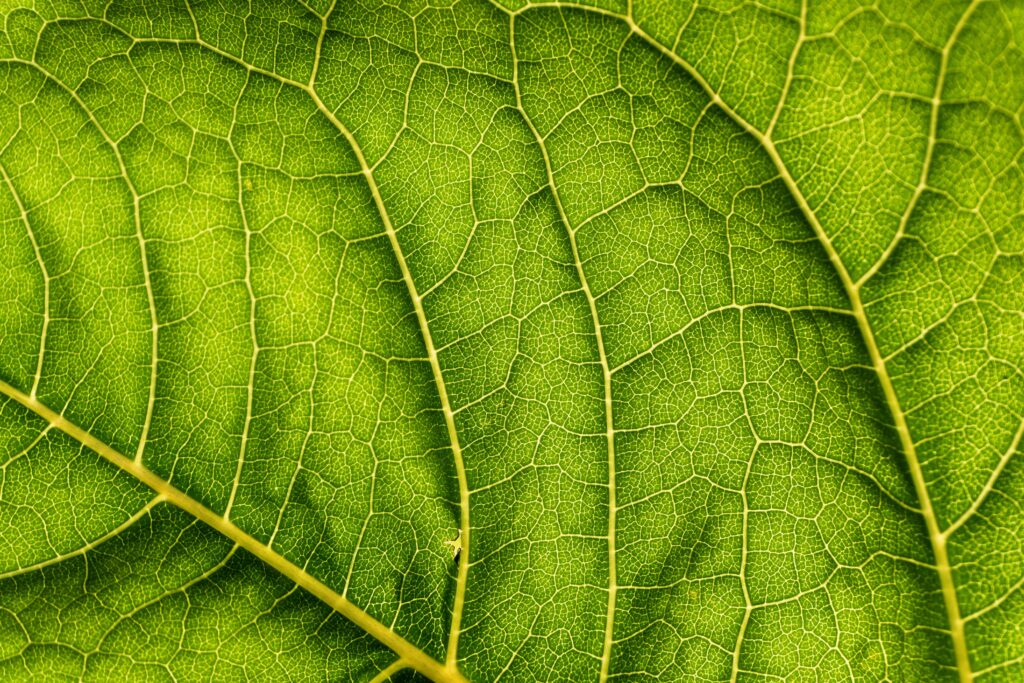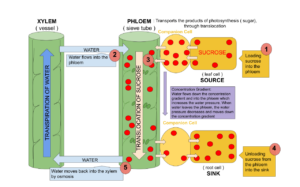
February 1, 2024
In earlier articles, JumpLights explored light intensity and quality, examining their effects on crop growth and productivity, and providing methods to calculate light conditions for optimized growth. The underlying mechanisms for these light effects are through complex photosynthesis and photomorphogenesis responses. An area less discussed in the literature, but also very important to optimizing growth, concerns the impact of light on translocation.
How do water and nutrients move through a plant?
Translocation refers to the movement of water, nutrients, and other substances within a plant. In plants, translocation occurs primarily through two types of vascular tissues: xylem and phloem.
- Xylem: Xylem is a key type of vascular tissue in plants. You’ll probably remember from high school biology that it transports water and minerals from the roots to the other parts of plants.
- Phloem: The other key type of plant vascular tissue, phloem moves food and nutrients from the leaves to different parts of plants.

Translocation in plants is essential for their growth, development, and survival. It facilitates the distribution of essential nutrients and water to all parts of the plant, supporting various physiological processes. Recently, researchers have been investigating how light affects the production and efficient partitioning of photoassimilates towards the harvestable organs of indoor and greenhouse crops.
The Impact on Light on Leaf Assimilate Translocation
Recent studies have shed light on the fundamental process of leaf assimilate translocation, by studying patterns of carbon dioxide exchange, translocation, and transpiration in tomato leaves grown under different wavelengths of light. Surprisingly, although other leaf changes occurred (stomata and transpiration rates) due to light quality, they found that all wavelengths of light, including orange and green, supported translocation from the leaf equally. They also found that likely due to competing processes that occur during dark, the export rates were higher from source to sink during light periods than at night [1].
A different observation was made studying cucumbers. In cucumbers, altering light intensity from 380 to 650 μmol/m 2 -s -1 significantly promoted the translocation of photoassimilates from leaves [2].
In marine environments, where light conditions are often variable and changing, light and dark transitions play a critical role in plant survival. For marine plants such as eelgrass, these transitions impact the partitioning of sucrose between roots and shoots differently than in the tomato and cucumber examples above, enabling the plant to adapt to fluctuating light conditions [3].
These results indicate a few conclusions. For one, it appears that different plant species react to light in translocation differently, which would result in testing different lighting strategies depending on the crop. For cucumber, increasing light intensity and/or DLI throughout the canopy might result in improved translocation. For tomato, on the other hand, extending the photoperiod (with intra-canopy lighting) may be the answer to driving assimilates from photosynthesis out of the leaves. Further research would need to be conducted by JumpLight scientists and partners to test this theory. In a previous article, JumpLights provides calculations to determine the light intensity needed for different photoperiods for anyone wishing to test equal DLI but altered PPFD/photoperiod side-by-side [4].
The Impact of Light on Nutrient Translocation into the Plant
Recent studies have revealed a significant link between light and potassium regulation in plants. The quality, intensity, and duration of light are crucial in regulating K nutrition. For instance, in tomatoes, blue/red illumination or a combination of red and blue light increases the expression levels of K transporter genes. This, in turn, boosts K uptake and accumulation, leading to enhanced lycopene synthesis and improved fruit color. These findings indicate a direct correlation between light conditions and the nutritional quality of fruits and vegetables [5].
Conclusion
Understanding how light affects water and nutrient translocation in plants can revolutionize agricultural practices. By manipulating light intensity and quality, growers can optimize conditions for plant growth and development, leading to increased crop yields and quality. This knowledge is particularly beneficial in controlled environments such as indoor farms and greenhouses, where light conditions can be precisely adjusted. Through careful monitoring of the latest science and the application of lighting solutions, like JumpLights above and under-canopy lighting, growers can discover methods to increase crop productivity by using the effects of light on translocation of nutrients.
References:
Image: Translocation from the source to the sink within the phloem.svg Created: 23 May 2019. Author Alyssa Pham under terms and conditions of Creative Commons CC BY-SA 4.0 Accessed: 22 January 2024
[1] Mauseth, J. D. (2019). Botany: An introduction to plant biology (7th ed.). Jones & Bartlett Learning.
[2] Proietti, S.; Paradiso, R.; Moscatello, S.; Saccardo, F.; Battistelli, A. Light Intensity Affects the Assimilation Rate and Carbohydrates Partitioning in Spinach Grown in a Controlled Environment. Plants 2023,12, 804. https://doi.org/10.3390/plants12040804
[3] Lanoue J, Leonardos ED and Grodzinski B (2018) Effects of Light Quality and Intensity on Diurnal Patterns and Rates of Photo-Assimilate Translocation and Transpiration in Tomato Leaves. Front. Plant Sci. 9:756. doi: 10.3389/fpls.2018.00756
[4] Trivellini, A.; Toscano, S.; Romano, D.; Ferrante, A. The Role of Blue and Red Light in the Orchestration of Secondary Metabolites, Nutrient Transport and Plant Quality. Plants 2023, 12, 2026. https://doi.org/10.3390/plants12102026
[5] Golam Jalal Ahammed, Yue Chen, Chaochao Liu, Youxin Yang, Light regulation of potassium in plants, Plant Physiology and Biochemistry, Volume 170, 2022, Pages 316-324, ISSN 0981-9428, https://doi.org/10.1016/j.plaphy.2021.12.019




